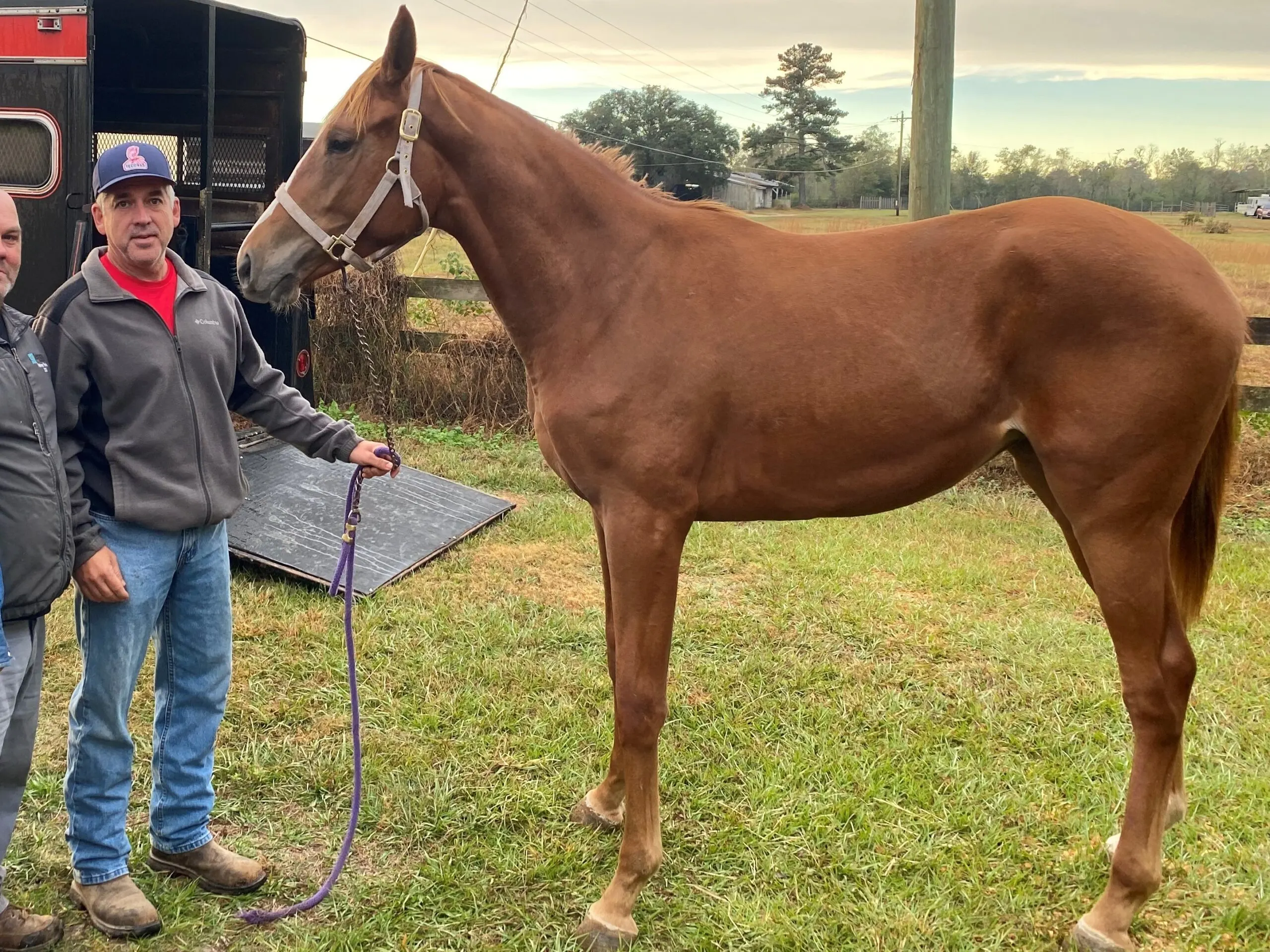Last updated: May 3, 2023
Our friend recently decided to run his three-year-old racehorse on grass since he didn’t fare well running over dirt. This change prompted my grandson to ask, why are some horse races on grass? I had my opinion but decided to research racing surfaces to provide a thorough answer.
Some horse races are on the grass to add variety and excitement to the competitions. But trainers choose to run horses on the surface that gives their horse the best chance to win, and some horses run better over a fast surface, and grass surfaces are typically firmer and faster than dirt.
Horse breeders, owners, and trainers believe they know which horses will run better on grass than dirt. But is there a way to understand what qualities make horses perform better over a particular track surface?

Horse racing on grass adds variety and excitement.
A horse race on natural grass is called a “turf” race. Natural grass surfaces are the most popular courses in Europe for flat-track horse racing. In the U. S., dirt track racing is dominant. In the United States, horse racing less than 10 percent of horse races are run on grass. However, horse racing in North America didn’t start that way.
Early Thoroughbred horse racing began on grass tracks, and some of the oldest surviving sports trophies commemorate turf champions. Such as the Colonial silver trophy from 1668 kept at Yale University, which recognized the Newmarket three-year-old grass course champion.
However, grass courses fell out of favor, primarily because they were hard to care for and couldn’t be used too often, are they would become unsafe. So, commercial tracks were designed for racing over dirt. Dirt tracks were so widespread that grass tracks almost went extinct, and in New York, they did.
It wasn’t until the early 1930s that there was interest in reviving the courses. Joseph E. Widener, the Hialeah race track president in Florida, installed a turf track in 1931. However, it wasn’t until the 1950s that grass tracks came roaring back to life.
European horses traditionally race on turf and came to the United States and dominated the prominent grass races. However, in the 1950s, that began to change. In 1953 the first American Male Turf Champion was awarded by Daily Racing Form and presented to Iceberg II. The prestigious award continues today and is a division of the Eclipse Awards.
Eclipse Award winners are chosen by the National Thoroughbred Racing Association (NTRA), Daily Racing Form, and the National Turf Writers Association. Turf racing allowed more horses to win races and earn money. Owners and trainers began pointing horses toward grass racing, and the public loved the change of pace and variety of added competitions, and gamblers loved the increased opportunities.

Some horses run better on grass tracks.
Horses are individuals, and some of them perform better at different distances and over specific surfaces. The same can be said for human athletes, some perform better in sprints or over asphalt, and some excel in marathons or running over a trail.
Anatomical differences play a role; often, tall horses with large hoofs tend to perform better on grass tracks. Because of their conformation, they don’t bog down in the grass like they often do in the dirt. Staying on top of the surface during the race allows them to run faster.
On dirt, these horses’ feet drive up and down through the soil, making them work extra to maintain their speed and typically tire them out quicker. However, some horses can transition between surfaces and win. Secretariat is a great example; he was dominant on all track surfaces.
Breeders often mate mares and stallions to produce offspring specifically to race on turf. Try as they may, it doesn’t always work out because a horse not bred for turf can run well on grass, but it isn’t as likely as those with turf-running bloodlines.
Halo was a superb sire of racehorses that performed well on turf and dirt courses, but he is remembered best for producing two Kentucky Derby winners. All of Halo’s significant victories were won on turf.

Grass tracks are easier on horse’s legs.
Turf courses are more forgiving than dirt tracks. The grass cushions the footfalls of horses and decreases the risk of injury. Another racing surface I haven’t mentioned is synthetic. This surface material also reduces injuries.
However, because there are many variables in synthetic courses’ manufacturing, the broad application of any statistics should be cautioned. In one British study, they concluded that softer racing surfaces were associated with fewer fatalities and injuries than firmer surfaces without distinguishing between the different textures.
Trainers are confident that turf races are more comfortable and less damaging to racehorses’ legs. In fact, some trainers often run a horse on the turf when they are sore or coming off an injury to give them time to heal before returning them to dirt racing.
Horses on a turf track tend to slip and slide less and generally come back healthier after a race. Another advantage often overlooked is that dirt clods and dust aren’t thrown in a horse’s face from leading horses’ hooves, as they are on dirt tracks.

Why aren’t there more turf horse races?
It seems turf has a lot of positives and few if any, negative aspects. So, why don’t they have more horse races on grass courses?
There aren’t as many turf courses in the United States as dirt tracks. Grass tracks are harder to maintain, get damaged easily, and don’t tolerate rain well.
All Thoroughbred race tracks in the United States have a dirt course, but they don’t all have a turf track. Dirt tracks are cheaper to install and maintain than grass courses. At the Fairgrounds racecourse, our home track, they have a turf course inside the dirt track.
But it is often used sparingly, and often turf races are moved to the main dirt course when the surface conditions aren’t ideal. The track administrator doesn’t risk tearing up his turf.

Great horses succeed regardless of the track surface.
The cream rises to the top; Secretariat, Dr. Fagar, and John Henry, three of the best racehorses to ever be saddled, could win over any surface. Secretariat walked onto the grass course for the first time after 19 dirt races, and it was phenomenal.
He won the Man o’War Stakes on October 8, 1973, and set a course record. His next race was the Woodbine, which he also won in commanding fashion.
Below is a YouTube video of Secretariat’s first turf race.
John Henry was one of the most amazing horses to ever race. He competed in 83 races, including 17 Grade I stakes wins and 39 first-place finishes. John Henry won the Grade 1 Turf Classic at Belmont and the Grade 1 Hollywood Turf Cup.
He was named Horse of the Year multiple times, as well as Turf Champion. It didn’t make a difference what surface he raced on; he was likely the best horse to grace the starting gates.
Dr. Fagar might be the greatest racehorse ever; he is arguably the fastest Thoroughbred of all time. He set a world record of 1:32 1/5 for the mile in 1968 and did it carrying 134 pounds. The extra weight didn’t slow Dr. Fagar.
He could accelerate quarter-mile splits faster than any other horse; in fact, he ran quarter-mile splits seven lengths faster than Secretariat. He won Horse of the Year, Handicap Horse of the Year, Sprinter of the Year, and Grass Horse of the Year. Dr. Fager beat two Horses of the Year, carrying no less than 130 pounds and as much as 139.
Dr. Fagar isn’t as well known outside of the racing world as the Secretariat or John Henry. This is through no fault of his or his accomplishments, but rather the era he competed. In 1968 Dr. Martin Luther King and Bobby Kennedy were assassinated, and unrest about the Vietnam War was gaining steam. In less turbulent times, Dr. Fagar would have captured the sports world’s attention.
Related articles:
- What Horses Won the Triple Crown? Meet 13 Great Champions
- What’s a Stakes Race In Horse Racing? How Horses Qualify.
- How Tall Are Jockeys, and How Much Do Jockeys Weigh?
- How Jockeys Choose the Horse They Ride: All You Need to Know
- Where Does the Purse Money Come From in Horse Racing?
- How Fast Can a Horse Run? Horse Racing Records
- Why do Jockeys Wear Silks?
Meet Miles Henry
An avid equestrian and seasoned racehorse owner, Miles Henry brings his extensive experience to the equine world, proudly associating with the AQHA, The Jockey Club, and various other equine organizations. Beyond the racetrack, Miles is an accomplished author, having published various books about horses, and is a recognized authority in the field, with his work cited in multiple publications.
🔗 Connect with Miles:
Twitter
Facebook
YouTube: Check out race highlights, horse care tips, and more!

